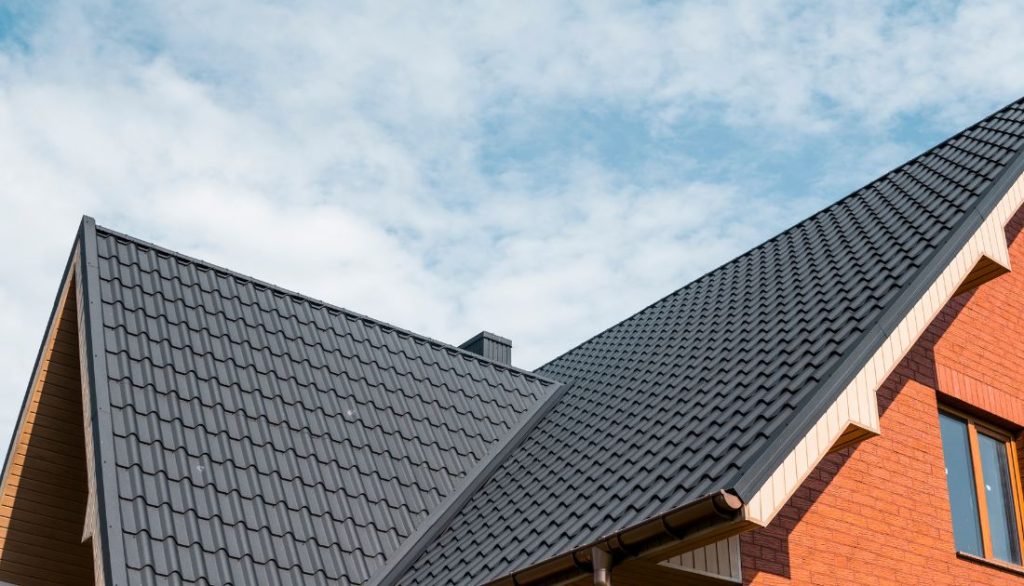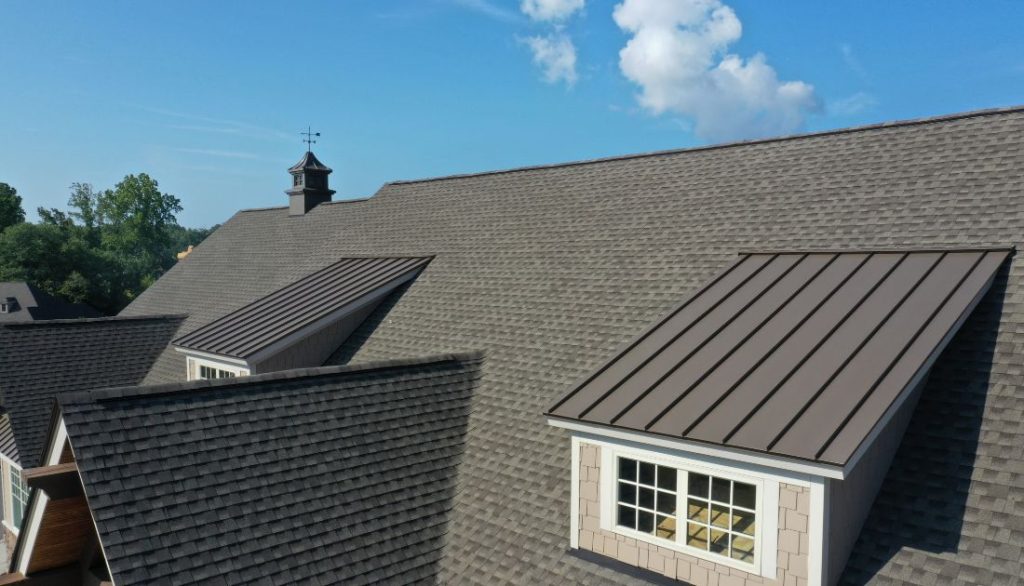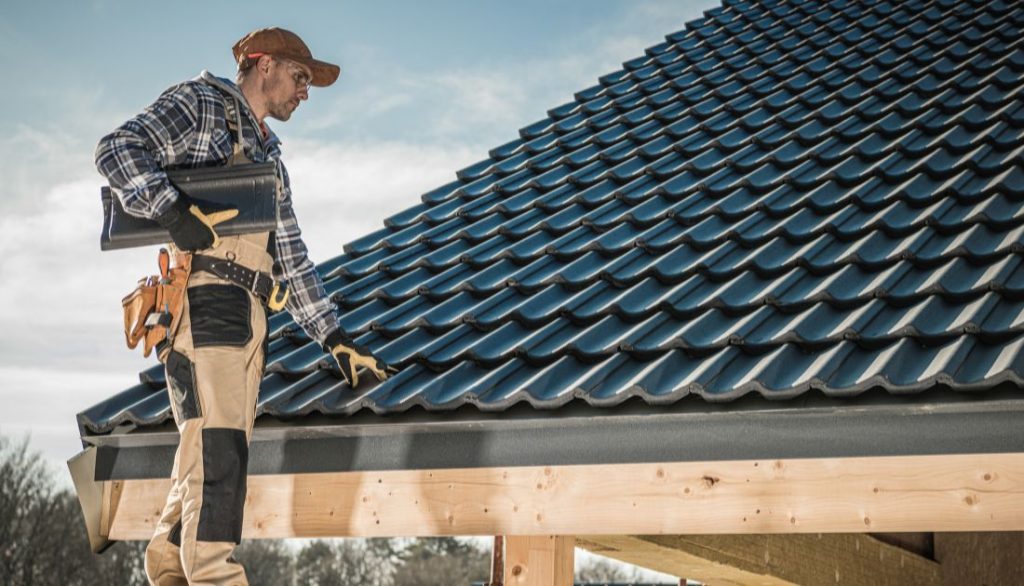Table of Contents
Two contenders are popular choices for homeowners nationwide in roofing materials: metal roof vs shingles. Each has advantages and drawbacks that must be carefully considered before deciding.
Metal roofs are durable roofing systems made from steel, aluminum, copper, and zinc alloys. They last 40-70 years and can withstand harsh weather conditions, including rain, snow, and wind.
Metal roofs are fire-resistant, energy-efficient due to their reflective properties, and environmentally friendly, often made from recycled materials. They come in various styles and finishes and offer superior performance, but they are more expensive initially and require specialized installation.
Shingles are popular roofing materials made from asphalt, wood, slate, or composites. Asphalt shingles are the most common and are known for affordability, ease of installation, and versatility. They last 20-30 years and provide good insulation. Shingles are easy to repair but need more maintenance than metal roofs and are prone to weather damage, mold, and algae growth.
Durability
Metal roofs are renowned for their outstanding longevity, often exceeding 50 years. They can withstand extreme weather conditions such as high winds, heavy snow loads, and hail.
On the other hand, shingle roofs have a lifespan of around 20-30 years and may require more frequent repairs or replacement due to damage from storms or harsh sunlight.
Cost Comparison
Metal roofs generally have a higher upfront price compared to shingles. However, metal roofs can be more cost-effective because of their longevity and durability. On the other hand, shingles may require frequent repairs and replacements, which can add to expenses.
Material quality, installation costs, and maintenance requirements are crucial in comparing metal roofs and shingles overall. While metal roofs offer long-term savings and energy efficiency benefits, shingle roofs are often preferred for their lower initial investment.
Aesthetics and Curb Appeal
When deciding between metal roofs and shingles, consider their aesthetic appeal. Metal roofs offer a modern and sleek look that can complement contemporary homes. On the other hand, shingles provide a more traditional appearance that may be better suited for classic or historic houses.
The curb appeal of your home is influenced by the choice between metal roofs and shingles. While metal roofs can give a house a unique and eye-catching appearance, shingles come in various colors and styles that allow for customization to match your home’s exterior design. Ultimately, the decision on aesthetics will depend on your personal preference and the architectural style of your property.

Environmental Impact
Longevity: Metal roofs have a longer lifespan than shingles, which need replacement every 15-30 years. This means less material waste over time.
Recyclability: Metal roofs are highly recyclable at the end of their life, reducing the amount of roofing materials ending up in landfills.
Energy Efficiency: Metal roofs can reflect solar radiant heat, keeping homes cooler and reducing energy consumption for air conditioning. This contributes to lower carbon emissions.
Maintenance Requirements
Metal roofs typically require less maintenance compared to shingle roofs. With metal, you won’t have to worry about replacing individual shingles that may come loose or get damaged over time. Regular inspections for rust or corrosion are recommended for metal roofs, but overall, they tend to be more durable and long-lasting.
Shingle roofs need regular maintenance to prevent leaks and ensure longevity. Over time, shingles can become loose, crack, or curl, requiring repairs or replacements. Regular cleaning of debris and moss is also essential to prolong the life of a shingle roof. Investing in professional inspections every few years can help catch any issues before they escalate into more significant problems.
Insulation and Energy Efficiency
Metal roofs are known for their superior energy efficiency compared to traditional shingle roofs.
The reflective properties of metal roofing can help reduce heat gain in the summer, ultimately lowering cooling costs.
Shingle roofs may not offer the same level of insulation as metal, leading to higher energy bills over time.
Metal roofs have a high solar reflectance, reflecting more sunlight than asphalt shingles. This reduces the amount of heat transferred into your home during hot weather.
Conversely, shingles absorb heat and transfer it into your living space, making your cooling system work harder to maintain a comfortable temperature.
Choosing a metal roof could save on energy costs and make your home more environmentally friendly at the same time.
Soundproofing and Noise Reduction
Metal roofs are known for being noisier during rain or hail storms compared to shingle roofs. The sound of rain hitting a metal roof can be quite loud, resembling the noise inside a drum. This can bother some homeowners, particularly those who value quiet indoors.
On the other hand, shingle roofs offer better soundproofing qualities due to their multiple layers of materials that help dampen external noises. The asphalt or fiberglass shingles absorb much of the impact from raindrops or hail, resulting in a quieter indoor environment. If noise reduction is a priority for you, shingle roofs might be the more suitable choice over metal roofs.
Installation Process
Metal Roofs: The installation process for metal roofs involves precisely measuring the roof’s dimensions. After that, individual metal panels are carefully cut and placed on the roof structure. Each panel is secured with screws to ensure stability and water-tightness. Finally, trim pieces are added to give the roof a polished look.
Shingles: Installing shingles starts with laying down a waterproof underlayment to protect against moisture. Next, shingle layers are meticulously placed in overlapping rows from the bottom up. Nails or adhesives secure each shingle in place. Finally, additional elements like ridge caps and flashing complete the installation process.

Advantages of Metal Roofs vs. Shingles
Metal roofs offer numerous advantages over shingled roofs, primarily due to their durability and longevity. Metal roofs can last 40-70 years, significantly longer than the 20-30 years typical for shingles. They are highly resistant to weather conditions, including heavy rain, snow, and high winds, and fire-resistant.
Additionally, metal roofs are energy-efficient, reflecting solar heat, which can reduce cooling costs in the summer. They are also environmentally friendly, often made from recycled materials, and fully recyclable at the end of their life. These benefits can lead to increased home value and lower long-term maintenance costs.
Disadvantages of Metal Roofs vs. Shingles
Despite their advantages, metal roofs have some disadvantages compared to shingles. The initial cost of metal roofing is significantly higher, making it a substantial upfront investment.
Installation is more complex and time-consuming, requiring specialized skills, which can further increase costs. Metal roofs can be noisier during rain or hailstorms, although this can be mitigated with proper insulation.
Additionally, while modern metal roofs are treated to resist rust, scratches or wear over time can lead to potential rust issues if not properly maintained. In contrast, shingled roofs are more affordable and easier to repair, making them a more accessible option for many homeowners.
Pros and Cons of Metal Roofs
Metal roofs offer numerous advantages, including exceptional durability, 40-70 years lifespan, and minimal maintenance requirements.
They are highly resistant to weather elements, fire, and insect damage, and their reflective properties can enhance energy efficiency, reducing cooling costs.
Additionally, metal roofs are environmentally friendly, often made from recycled materials, and can be fully recycled at the end of their life.
However, metal roofs’ initial cost is higher than shingled roofs. They can also be noisier during rain or hail, though proper insulation can mitigate this. Installation requires specialized skills, potentially increasing labor costs.
Pros and Cons of Shingled Roofs
Shingled roofs are popular for their affordability and ease of installation. They offer various styles and colors, making them versatile for various home designs. The initial cost is significantly lower than metal roofs, and repairs are relatively simple and inexpensive.
Shingled roofs also provide good insulation against both heat and cold. However, they have a shorter lifespan, typically 20-30 years, and require more maintenance over time. They are more susceptible to damage from severe weather, such as high winds and hail. Also, shingles can develop mold, mildew, and algae growth if improperly maintained.

FAQs
What is the installation time difference between a metal roof and a shingled roof?
Installing a metal roof generally takes longer than installing a shingled roof due to the need for more precise measurements and fastening techniques. On average, a metal roof installation can take a few days to a week, whereas a shingled roof can often be installed in 1 to 3 days.
Which is more cost-effective: metal roof or shingles?
Shingled roofs are usually cheaper to install initially compared to metal roofs. However, metal roofs can be more cost-effective in the long run due to their longer lifespan, lower maintenance requirements, and potential energy savings.
Is the additional expense of a metal roof justified?
The extra cost of a metal roof can be justified by its durability, longevity (lasting 40-70 years compared to 20-30 years for shingles), lower maintenance, and potential energy efficiency. Additionally, metal roofs can increase a home’s resale value.
Are metal roofs more prone to leaking compared to shingled roofs?
If installed correctly, metal roofs are not more prone to leaking than shingled roofs. They are often more resistant to leaks due to fewer seams and their interlocking design.
Do metal roofs have a risk of rusting?
Metal roofs can rust if not properly coated or maintained. However, most modern metal roofs are made with rust-resistant coatings and materials, such as galvanized steel or aluminum, significantly reducing the risk of rust.
How long does a metal roof typically last?
A metal roof typically lasts between 40 to 70 years, depending on the material and quality of installation. This is significantly longer than the lifespan of a traditional shingled roof, which usually lasts between 20 to 30 years.
